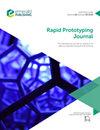Single-filament-wide tensile-testing specimens reveal material-independent fibre-induced anisotropy for fibre-reinforced material extrusion additive manufacturing
IF 3.6
4区 工程技术
Q1 ENGINEERING, MECHANICAL
引用次数: 1
Abstract
Purpose This study/paper aims to develop fundamental understanding of mechanical properties for multiple fibre-reinforced materials by using a single-filament-wide tensile-testing approach. Design/methodology/approach In this study, recently validated single-filament-wide tensile-testing specimens were used for four polymers with and without short-fibre reinforcement. Critically, this specimen construct facilitates filament orientation control, for representative longitudinal and transverse composite directions, and enables measurement of interlayer bonded area, which is impossible with “slicing” software but essential in effective property measurement. Tensile properties were studied along the direction of extruded filaments (F) and normal to the interlayer bond (Z) both experimentally and theoretically via the Kelly–Tyson model, bridging model and Halpin–Tsai model. Findings Even though the four matrix-material properties varied hugely (1,440% difference in ductility), consistent material-independent trends were identified when adding fibres: ductility reduced in both F- and Z-directions; stiffness and strength increased in F but decreased or remained similar in Z; Z:F strength anisotropy and stiffness anisotropy ratios increased. Z:F strain-at-break anisotropy ratio decreased; stiffness and strain-at-break anisotropy were most affected by changes to F properties, whereas strength anisotropy was most affected by changes to Z properties. Originality/value To the best of the authors’ knowledge, this is the first study to assess interlayer bond strength of composite materials based on measured interlayer bond areas, and consistent fibre-induced properties and anisotropy were found. The results demonstrate the critical influence of mesostructure and microstructure for three-dimensional printed composites. The authors encourage future studies to use specimens with a similar level of control to eliminate structural defects (inter-filament voids and non-uniform filament orientation).单丝宽拉伸试样揭示了纤维增强材料挤出增材制造中与材料无关的纤维诱导各向异性
目的本研究/论文旨在通过使用单丝宽拉伸试验方法,加深对多种纤维增强材料力学性能的基本理解。设计/方法/方法在这项研究中,最近验证的单丝宽拉伸试样用于四种具有和不具有短纤维增强的聚合物。至关重要的是,对于具有代表性的纵向和横向复合材料方向,这种试样结构有助于控制细丝方向,并能够测量层间结合面积,这在“切片”软件中是不可能的,但在有效的性能测量中是必不可少的。通过Kelly–Tyson模型、桥接模型和Halpin–Tsai模型,从实验和理论上研究了沿挤出长丝(F)方向和垂直于层间键(Z)的拉伸性能。发现尽管四种基体材料的性能差异很大(延展性差异1440%),但在添加纤维时,发现了一致的与材料无关的趋势:F方向和Z方向的延展性均降低;刚度和强度在F中增加,但在Z中降低或保持相似;Z: F强度各向异性和刚度各向异性比增加。Z: F断裂应变各向异性比降低;刚度和断裂应变各向异性受F特性变化的影响最大,而强度各向异性受Z特性变化的最大。独创性/价值据作者所知,这是第一项基于测量的层间结合面积评估复合材料层间结合强度的研究,并发现了一致的纤维诱导性能和各向异性。结果表明,细观结构和微观结构对三维印刷复合材料的影响至关重要。作者鼓励未来的研究使用具有类似控制水平的试样来消除结构缺陷(细丝间空隙和细丝方向不均匀)。
本文章由计算机程序翻译,如有差异,请以英文原文为准。
求助全文
约1分钟内获得全文
求助全文
来源期刊

Rapid Prototyping Journal
工程技术-材料科学:综合
CiteScore
8.30
自引率
10.30%
发文量
137
审稿时长
4.6 months
期刊介绍:
Rapid Prototyping Journal concentrates on development in a manufacturing environment but covers applications in other areas, such as medicine and construction. All papers published in this field are scattered over a wide range of international publications, none of which actually specializes in this particular discipline, this journal is a vital resource for anyone involved in additive manufacturing. It draws together important refereed papers on all aspects of AM from distinguished sources all over the world, to give a truly international perspective on this dynamic and exciting area.
-Benchmarking – certification and qualification in AM-
Mass customisation in AM-
Design for AM-
Materials aspects-
Reviews of processes/applications-
CAD and other software aspects-
Enhancement of existing processes-
Integration with design process-
Management implications-
New AM processes-
Novel applications of AM parts-
AM for tooling-
Medical applications-
Reverse engineering in relation to AM-
Additive & Subtractive hybrid manufacturing-
Industrialisation
 求助内容:
求助内容: 应助结果提醒方式:
应助结果提醒方式:


